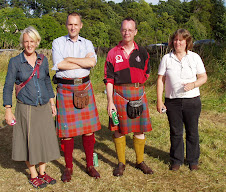I am beginning to feel somewhat recovered, and should perhaps touch on actual knitting.
I did pretty well with the final pink Araucania sleeve while we were away. I had only just cast it on, the time before.
I did pretty well with the final pink Araucania sleeve while we were away. I had only just cast it on, the time before.

Here, I finished a second swatch of the meandering Celtic pattern last night, liked it better knit with a larger needle, made some calculations – I do hate thinking – and cast on the sweater. I eliminated various patterns from my original draft, but even so, it looks large. (I’m aiming, roughly, at a 30” child-sized circumference.) I considered starting again, and decided against it. The worst case scenario is having to order more yarn. If I press on briskly as intended, there may not even be a dye-lot problem.
And as for ordering yarn, I emailed Loop about what seemed to me continuing gaps in their madeleinetosh sock yarn page. I didn’t entirely understand their reply, which indicated that they hadn’t entirely understood my email and also said something about July. I decided to give up, concentrate on the colour-ways which (a) are illustrated and (b) offer enough skeins for my purposes, and just order. I’ve gone for “Cosmos”.
Vegetable-growing
I am very interested in Ruth Stout’s book, “Gardening Without Work”. The idea can be expressed in a sentence – cover everything with a thick layer of organic mulch. But the book is also delightful, and thought-provoking.
I don’t think my husband is likely to let me order in a load of spoiled hay. But I think I can muster enough compost & manure & grass-cuttings & bracken & what-not to try it on parts of the garden anyway. Stout says, start NOW. I am at the one moment of the year when I can’t do that, because the vegetable seedlings are so tiny. I can at least start throwing stuff at the potatoes, instead of earthing them up, and intend to do so.
She mentions two problems, lime and nitrogen.
I don’t understand lime AT ALL. If what I say below is right, it is only because I have learned it by rote.
We have acid soil, that means low-lime, that means rhododendrons and blueberries are happy and most vegetables not. Lime seems to be a sort of insulin for soil – not itself a nutrient, but necessary in most cases for plants to make full use of what is there. Stout seems to hope that her system keeps things right, without the need for added lime.
I had thought the opposite. I thought adding manure & compost makes soil more acid, even if it wasn’t already. That is, that lime and manure complement and in a sense oppose each other. There is after all that old farmer’s saying, “Lime and lime without manure/ something something something sure”.
And someone told her that her system was short on nitrogen, so she scatters something I have never heard of on top of the hay in the fall. I’m not too worried about that one. Peas and beans fix nitrogen in the soil, to begin with. And I intend to go on, whatever happens, sprinkling blood, hoof and bone meal along the soil when I am about to put seeds in.



..."/Makes both farm and farmer poor"
ReplyDeleteOur soil consists mostly of sand, and I've found that covering it with grass clippings really helps with keeping the soil moist.
I've used salt hay as mulch for a few years now. The advantage over grass clippings is that there are no weed seeds that will sprout in the soil. I can lift a bale of it by myself. Cost in NJ, USA is about 20 for enough to cover a 20' by 20' garden perfectly.
ReplyDeleteBeverly in NJ
As I understand it, rotting hay (etc) temporarily binds the nitrogen, so the soil is temporarily low in that nutrient. However, once the cellulose is fully rotted, the nitrogen again becomes available to the plants, so eventually a kind of steady state is achieved. Manure provides the nitrogen. It's possible that lime makes the soil more supportive of the good bacteria.
ReplyDeleteNot exactly organic mulch, but I covered my veg patch with old carpet tiles from January through to May and the result was a warm, friable weed-free garden! Bargain!
ReplyDeleteI use spent mushroom compost instead of lime. I don't use it on every bed every year but alongside the crop rotation, usually before I plant the brassicas.
ReplyDeletehttp://apps.rhs.org.uk/advicesearch/Profile.aspx?pid=294
Rotted manure and compost are usually neutral to mildly alkaline btw, according to the RHS in the above link.
Hello
ReplyDeleteI just stumbled across your blog and have been interestedly rooting through your archives. I'm a knitter not a gardener - well not currently, I'm a village dweller with a tiny courtyard garden who is waiting on an allotment - so can contribute nothing useful re. the mulch/manure/compost debate, but I shall enjoy reading about your growing efforts nonetheless, and will definitely be back to read more of the knitterly stuff.
I know very little about gardening, but my web search found another ending to your rhyme as well some words on the use of lime:
ReplyDelete"there is an old rhyme about "Using lime without manure, makes a man rich and his son poor".
Just a general warning in case anyone thinks of doing that.
I understand (vaguely) that the lime helps release nutrients from organic matter in the soil, so if you don't replenish the organic matter then the soil gets worn out."